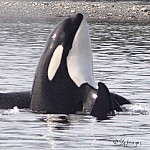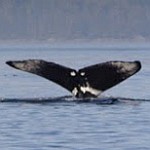Harbour Porpoise
Harbour porpoise eat a variety of squid and fish, including Herring, Hake, and Pollock. Harbour porpoise have been observed to forage and feed cooperatively, even with their cousins the Dall’s Porpoise.
Dall’s Porpoise
Dall’s porpoise eat a variety of squid and fish, including Herring, Hake, Sardines, and Anchovies. Studies have shown that Dall’s porpoise in some areas feed on deep-water species of fish such as Lanternfish.
Pacific White-Sided Dolphin
A pod of Pacific White-Sided dolphins may spread out to cover a large area when foraging. Occasionally, individuals have been observed to hit the water with their head or tail when feeding. Pacific White-Sided dolphins eat a number of different species of squid and fish. Their diet includes schooling fish such Anchovies, Sardines, Herring, and Salmon.
Minke Whale
Minke whales prey on a number of species of fish, including Sandlance, Anchovies, and Herring. They may also feed on zooplankton and krill. Minke whales use their baleen to filter their prey from the water that they expel from their mouths. Minke whales use the lunge feeding technique, lunging through a school of fish or krill with their mouth wide open to maximize the number they catch.
Gray Whale (Grey Whale)
Gray whales filter-feed on zooplankton found near the ocean surface. However, they are different from other baleen whales because they feed mainly on animals found on or near the sea floor usually close to shore. Their diet includes a variety of tube worms, shrimp, and small crustaceans called amphipods. Gray whales feed by swimming and rubbing along the sea floor while sucking in water, sediments, and prey. The water and sediments are expelled from their mouths with the baleen trapping their prey inside their mouths, which are then consumed.
Humpback Whale
Humpback whales are filter-feeders and eat krill as well as other free-floating crustaceans. Humpback whales also feed on schooling fish such as Sardines, Sandlance, and Herring. They have been observed to use the lunge feeding technique to catch fish. Usually in groups of three or more, some of them use the bubble-net technique to catch fish in a cooperative manner. Humpback whales have baleen, a type of filter in their mouth rather than teeth. They take in a large amount of water and fish, expanding their throat which has special pleats for this purpose. As they close their large mouth, Humpbacks force the water out through the baleen filter and then, swallow the prey that remain.
Orca – Resident Killer Whales
Resident Orca eat only fish, mainly salmon. These Orca are seen with high frequency around inland waters of B.C. when the salmon are in high abundance during the summer and fall months. Of all the species of salmon, the preferred prey is Chinook, also known as King salmon due to their size and fat content. Unfortunately, Chinook salmon stocks have been in decline which has affected the populations of some pods of Resident Orca.
Resident Orca use echolocation to detect their prey. They communicate through a great variety of vocalizations with members of their pod when hunting because they spread out when foraging. However, each Orca needs to catch its own prey and rarely is prey capture done cooperatively among adults.
Orca – Transient Biggs Killer Whales
Transient Biggs Orca prey on marine mammals such as seals, sea lions, porpoise, dolphins, and even larger whales. Occasionally, they may even prey on birds, sea turtles, and sharks. Transient Biggs Orca hunt their prey in silence so that they do not alert their prey of their presence. They listen to noises created by their prey to locate them. They work cooperatively to catch, overwhelm, and kill their prey. As with all Orca, the Transient Biggs Orca share their prey with other members of their pod.


